Swiss meringue buttercream is a thick, silky, and stable frosting that you can make with just 4 ingredients! This classic frosting holds its shape well, making it ideal for piping and decorating cakes and cupcakes.
Looking for a chocolate version? Try my chocolate Swiss meringue buttercream recipe, next.
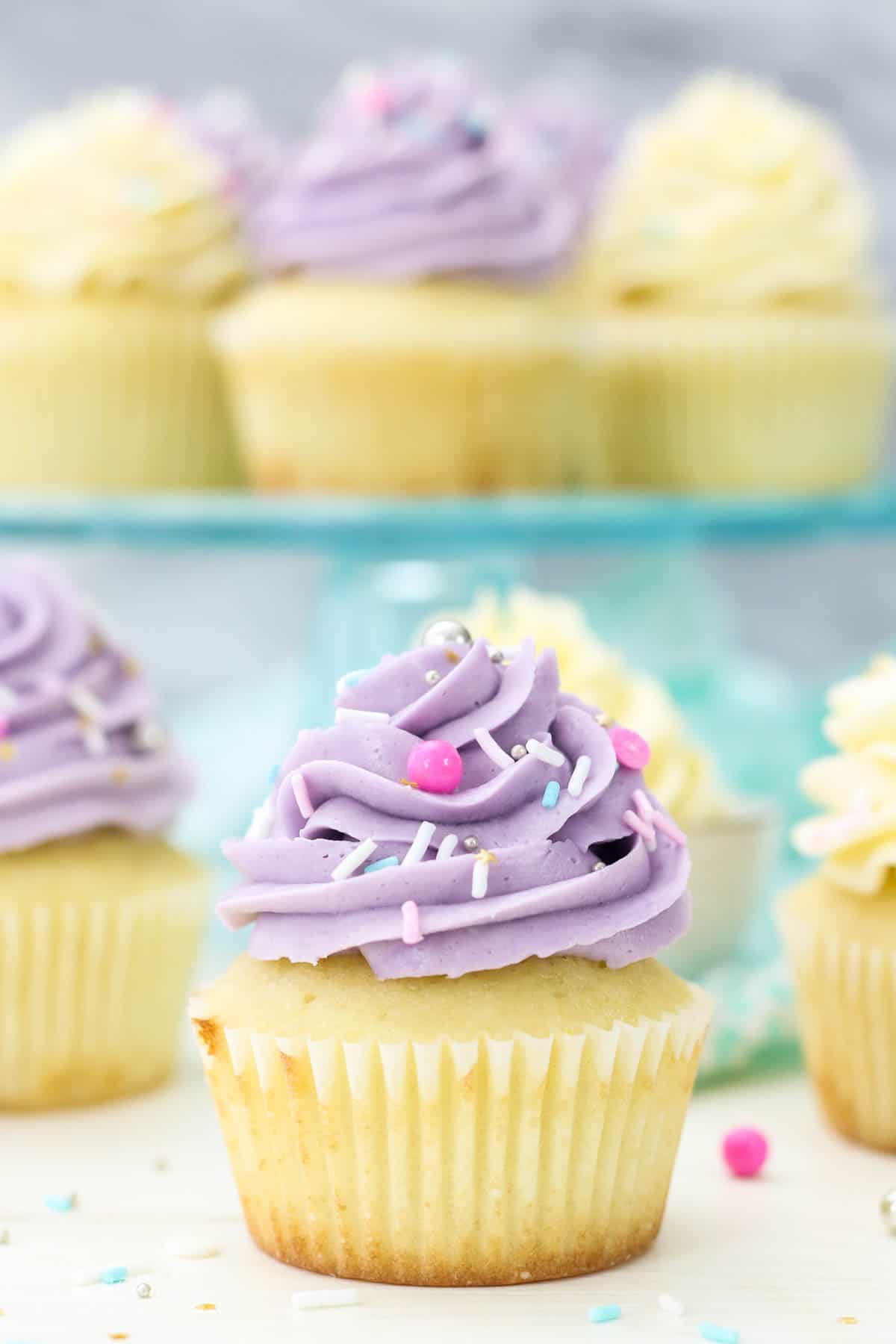
Swiss meringue buttercream, sometimes shortened to SMBC, is a light, silky, and buttery alternative to traditional American buttercream frosting. It’s made by heating egg whites and whipping them together with sugar and butter until fluffy. My love affair with this particular frosting began in the VERY early days of my blog, and it quickly became one of my favorite frosting recipes. It was only a matter of time before I created a step-by-step for those who’d like to make perfect Swiss meringue!
Give This Swiss Meringue Buttercream A Try
- Frosting, elevated. There’s something luxurious about Swiss meringue frosting. It’s less sweet than traditional American buttercream, with a rich, silky taste and thick, pipable texture.
- Easy method. If the thought of homemade meringue sounds intimidating, I think you’ll be pleasantly surprised by this recipe. It’s very easy and I’ll walk you through how to dissolve the sugar and whip the egg whites into a fluffed, perfect frosting.
- 4 ingredients. You don’t need any fancy ingredients to make this “fancy” frosting from scratch. Just eggs, sugar, butter, and vanilla.
- Perfect for decorating. Swiss meringue buttercream has a light, airy, and stable consistency that makes it the BEST for piping onto cakes and cupcakes.
How Is This Different From Regular Buttercream Frosting?
The main difference is that Swiss meringue buttercream is made with cooked sugar and egg whites, while American buttercream uses powdered sugar and no eggs. American buttercream tends to be sweeter, while Swiss buttercream has a stronger butter flavor due to the higher butter content.
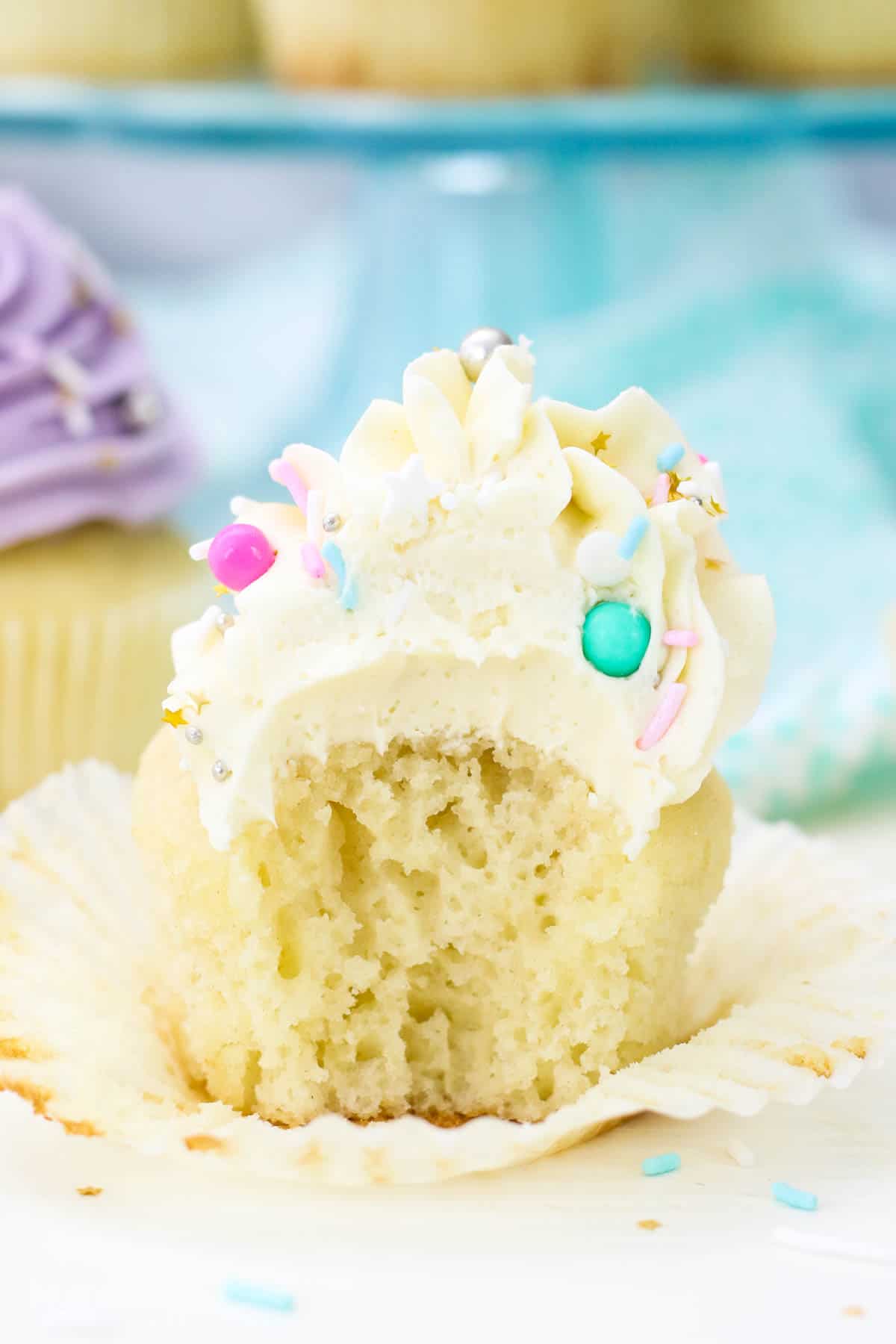
Ingredient Notes
Here’s an overview of what you’ll need for this Swiss meringue buttercream recipe. Be sure to scroll down to the bottom of the post for the full, printable recipe card with the full amounts and details.
- Egg Whites – Egg whites are essential in meringue recipes. It’s much easier to separate eggs when they’re cold from the fridge. Let the egg whites come to room temperature afterward.
- Sugar – You’ll want to use granulated white sugar for a crisp, white meringue.
- Butter – Most of my frosting recipes begin with cold butter, however, Swiss meringue is the exception! Like the egg whites, the butter for this recipe should also be at room temperature. I recommend using unsalted butter and adding salt to taste (I’ve found that salted butter makes this frosting way too salty).
- Vanilla Extract – Traditional Swiss meringue buttercream calls for high-quality vanilla extract or vanilla bean paste. If you’d like to flavor your frosting differently, you can also use another extract, like peppermint. See further in the post for my variation ideas.
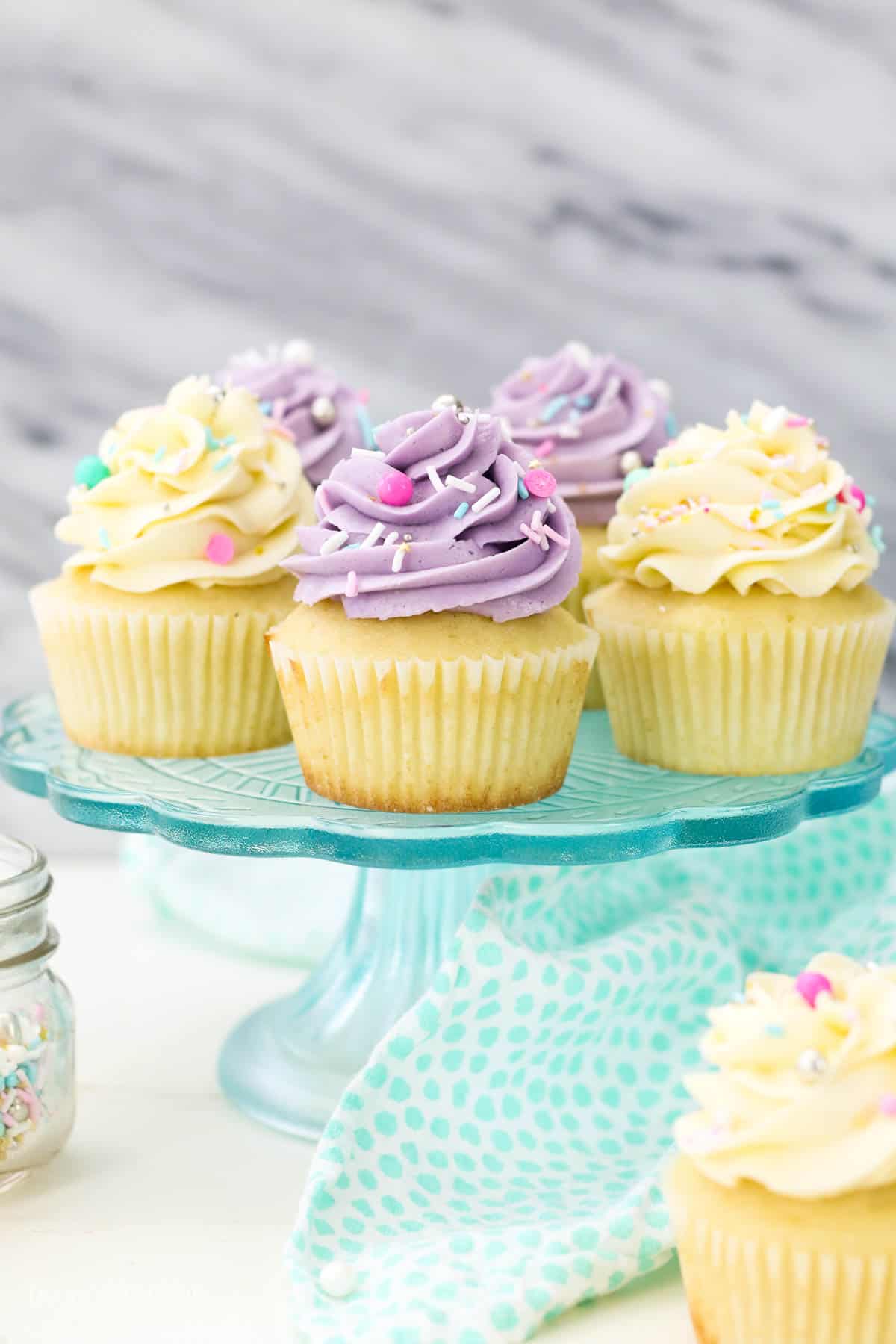
How to Make Swiss Meringue Buttercream
The steps below show how to make perfect Swiss meringue buttercream frosting from start to finish. You’ll find the printable instructions in the recipe card after the post.
Before You Begin, Clean Your Tools
The tools you’re using must be free from any residual oil or grease, otherwise, the meringue will flop. Oil and meringue do NOT mix. I like to give the bowl of my stand mixer and the attachments a good wipe-down with vinegar to remove any greasiness before I make the frosting.
- Combine. In a squeaky-clean stainless steel bowl, heat the egg whites with sugar in a double boiler over medium heat.
- Dissolve the sugar. Whisk constantly until the sugar dissolves, which usually happens at around 140-160ºF (use a candy thermometer if you have one). When you rub a drop of egg whites between your fingers, it should feel smooth, not gritty.
- Beat the egg whites. Next, move the bowl to your stand mixer and beat the egg whites with the whisk attachment. Start slow before gradually increasing the mixer speed. Keep whipping for 7-10 minutes, until the frosting turns white and forms glossy, stiff peaks.
- Add butter. Now, slowly add the butter to the meringue a little at a time. You may notice your glossy meringue looks a bit curdled at this stage, but don’t panic!
- Beat again. Once the butter is incorporated, switch to the paddle attachment and beat the frosting again. The curdled frosting should start to stiffen, and after 3-5 minutes, it’s ready to use.
Recipe Tips
- Where possible, use only metal tools. Wipe the bowl, mixer attachments, etc. down with vinegar (or lemon juice) to completely remove any leftover grease.
- Make sure your butter is at room temperature. If your butter is too cold, you’ll end up with clumps of butter in your frosting. Likewise, if the butter is too warm, it can cause the buttercream to separate. The butter should be soft enough that it indents easily when you press it with your finger, but not melty.
- Don’t overcook the egg whites. Place the pot for your double boiler over medium heat, and don’t pre-boil the water. If the egg whites heat up too fast, they’ll cook and scramble. If this happens, unfortunately, you’ll need to discard them and start over.
- To see if your sugar is fully dissolved, drizzle some of the egg whites on your fingertips and gently rub them together. The mixture should be completely smooth.
- Make bright white frosting. Use colorless imitation vanilla extract if you’d prefer your SMBC to stay a crisp bright white. You’ll find this at most craft stores or specialty cake stores.
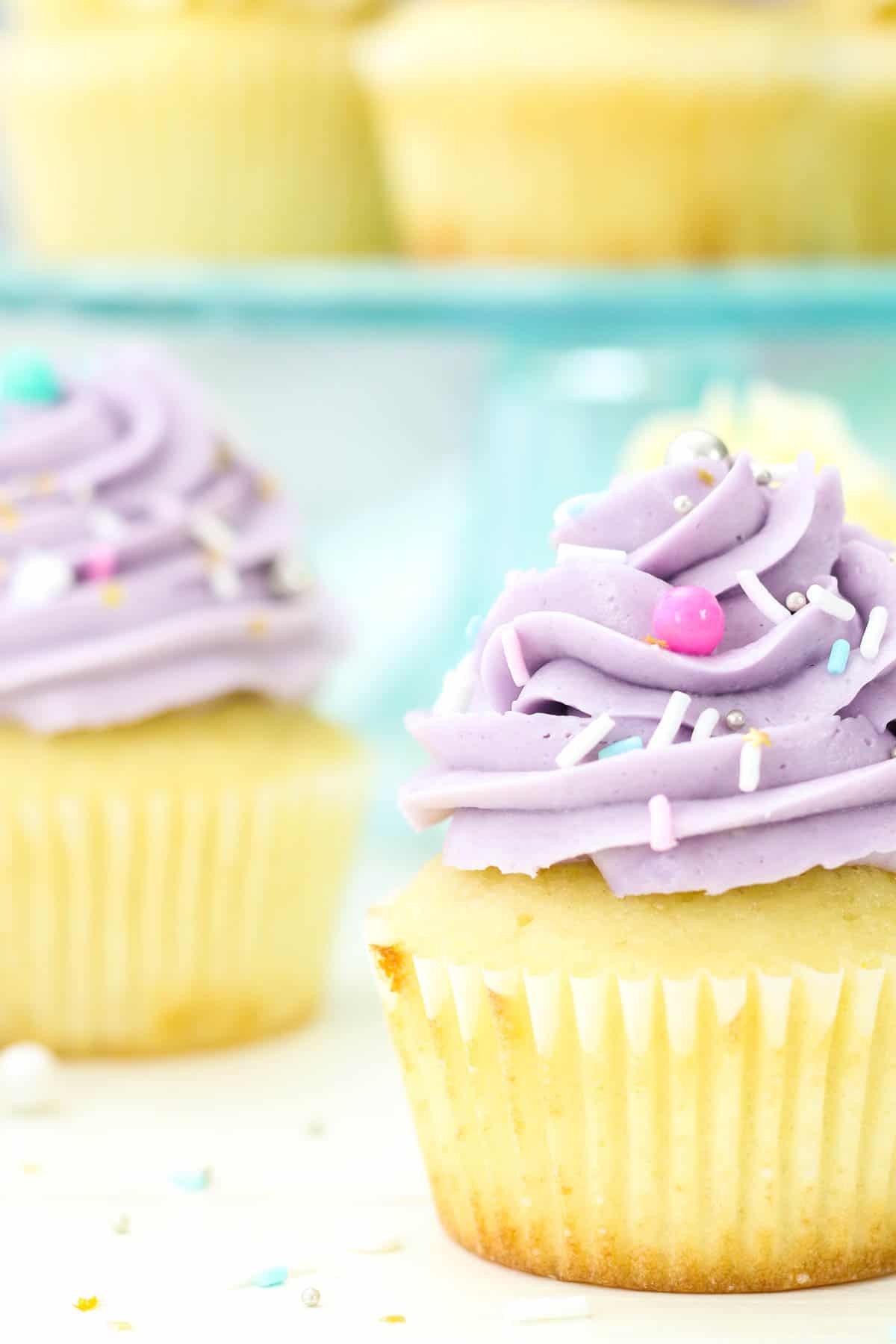
Flavor Variations
There are many ways you can change up this buttercream frosting to suit just about any cake or dessert. Here are some ways to flavor Swiss meringue buttercream:
- Extracts. This is the easiest way to flavor frosting. Use high-quality flavoring extracts like almond, lemon, peppermint, or another flavor you prefer.
- Fruit. Add fresh strawberry purée to this frosting, like I did for my strawberry margarita cake. I’ve also made blackberry buttercream before with great results. Freeze-dried fruit is another great way to add flavor to frosting recipes (like the freeze-dried strawberries I use in the frosting for my strawberry cake).
- Marshmallow. My marshmallow frosting is a fun spin on classic SMBC that tastes just like fluffy marshmallows.
- Zest. Add lemon, lime, or orange zest to make a fresh citrusy buttercream, like the orange Swiss meringue used for my mimosa cake.
Frosting FAQs
No, you don’t want to use margarine or any other baking spread in place of butter in Swiss meringue recipes.
The egg whites will lose air and curdle during the process of adding the butter. A good whip usually sorts this out, for a stiff, stable final product. It has never happened to me, but I have read that if your frosting is still a bit soupy even after you whip it, you can pop it into the fridge for 10-20 minutes and then re-whip it.
Yes. As written, this recipe makes about 5 cups of frosting, enough to frost approximately 24 cupcakes. To make enough frosting for an 8” three-layer cake, for example, you’ll need to use 10 large egg whites, 3 cups of unsalted butter, and 2½ cups of granulated sugar, plus your extract.
Yes. I recommend using gel colors to color Swiss meringue buttercream. Add the color gradually (a little goes a long way) and gently fold it in using the paddle attachment on your mixer, or a spatula. I have a post on how to color buttercream that goes into this in-depth.
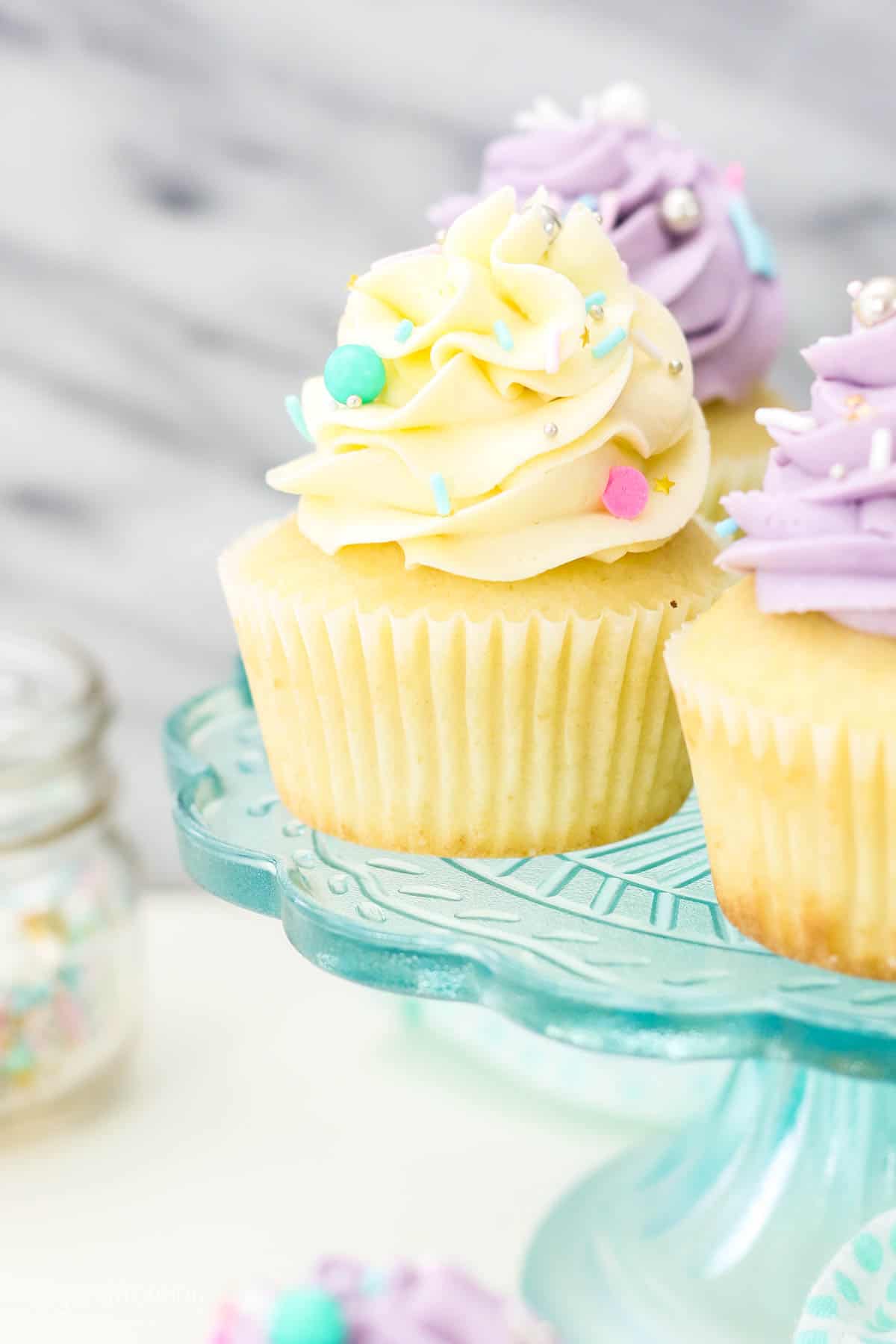
Ways to Use Swiss Meringue Buttercream
Swiss meringue buttercream’s light and airy texture makes it especially ideal for piping over layer cakes, cupcakes, and more. It’s also less sweet than other traditional types of frosting. This makes it a good match with recipes where you’d like the true flavors of a cake or cupcake to shine.
I love pairing Swiss meringue frosting with vanilla cake or vanilla cupcakes for a classic combination. It’s my frosting of choice for this festive chocolate peppermint cake and also goes great with recipes like my champagne cupcakes, lemon raspberry layer cake, and lemon blueberry cake.
Meringue does make a softer frosting, so frosted desserts are best served right away or stored as soon as possible. See the next section for details.
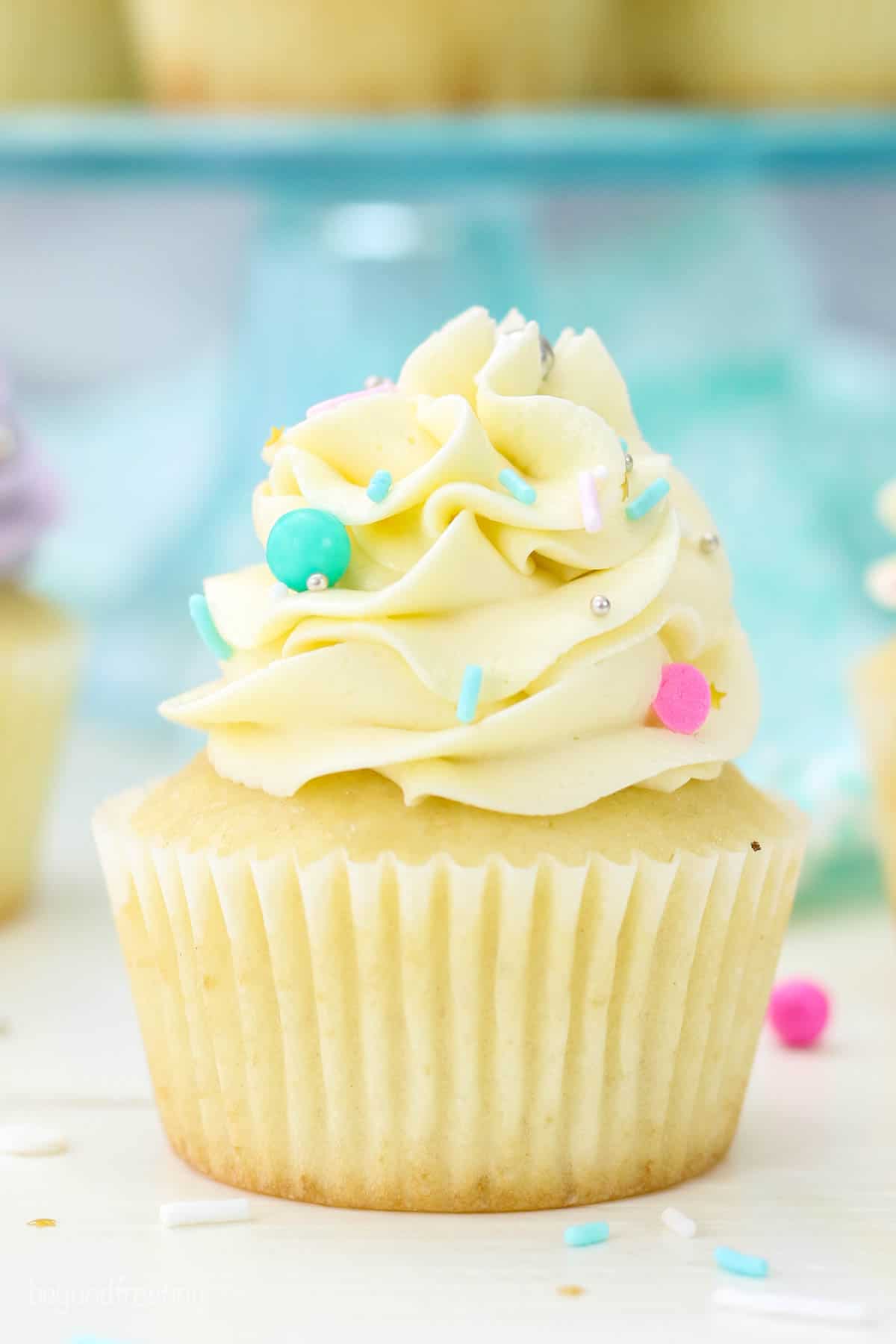
How to Store
- Store leftover buttercream. Keep this Swiss meringue buttercream in an airtight container in the fridge for up to 7 days. It will harden when chilled, so I recommend bringing the frosting back to room temperature and giving it a fresh whip with the paddle attachment of a stand mixer before you use it.
- Freeze. Most Swiss meringue buttercream frostings are fine to freeze for up to 3 months. Thaw the frosting completely to room temperature and re-whip it before you use it.
More Easy Frosting Recipes
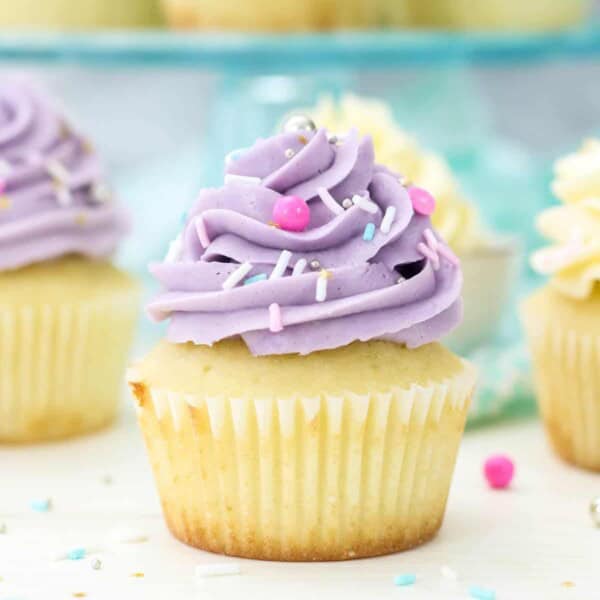
Swiss Meringue Buttercream Recipe
- Prep Time: 30 minutes
- Cook Time: 10 minutes
- Total Time: 40 minutes
- Yield: 5 cups or 24 cupcakes
- Category: Frosting
- Method: Stovetop
- Cuisine: American
Description
This easy Swiss meringue buttercream recipe makes thick, stable frosting perfect for decorating cakes and cupcakes! Made with whipped egg whites, sugar, and butter, you can flavor it with any extract you’d like.
Ingredients
- 5 large egg whites at room temperature
- 1 cup plus 2 tablespoon granulated sugar
- 2 cups unsalted butter at room temperature
- 1 teaspoon pure vanilla extract
Instructions
- Wipe down the inside of your stainless-steel bowl with vinegar to remove any grease. Combine sugar and egg whites in the bowl with candy thermometer attached.
- Set the bowl over top of a pot with 1 ¼ cups water covering the bottom. Place over medium heat.
- Stir constantly with a whisk until the mixture reaches 140°-160° The sugar should be dissolved in the egg whites. You can test this by placing a drop on your finger tips and rubbing them together. The mixture should be completely smooth.
- Immediately place the mixing bowl on your stand. Using the wire whisk attachment, beat the eggs white on low for 2 minutes than increase to medium high.
- Beat for another 5 minutes. At this point, your frosting should have turned white and the body of the meringue starts to form. Increase the mixing speed to high. It will start to look glossy as the peaks begin to form. Beat for another 3-5 minutes until the bottom of your bowl is cool to the touch and your meringue has stiff peaks.
- Turn your mixer down to medium-low. Slowly add your butter, 1 tbsp at a time. As you add more butter, the frosting might appear to have curdled and lost its body, that’s ok. Scrape down the sides of the bowl.
- Switch to the paddle attachment, add the vanilla extract and continue beating on medium-high speed until your frosting start to have stiff peaks. Beat for about 3-5 minutes.
Notes
- Original frosting recipe adapted from Martha Stewart.
- The utensils have to be grease-free, wipe down your bowls, whisks, and spatulas with vinegar or lemon juice prior to starting
- Use a candy thermometer for the most accurate temperature.
- Always use unsalted butter! This allows you to control how much salt is in your frosting.
- To tint the buttercream, slowly add the color gel and beat with a paddle attachment, or fold it in with a spatula until completely incorporated.
- Flavor variations:
- This can easily be flavored with any type of extract vanilla bean, peppermint, almond, lemon, etc. Start with ½-1 teaspoon at a time. Lemon, lime, or orange zest is a great way to add a more intense flavor.
- See the full tutorial for my chocolate Swiss meringue buttercream for a chocolate variation.
- Strawberry or blackberry purees can be added for natural flavoring.
Nutrition
- Serving Size: 1 cupcake’s worth
- Calories: 176
- Sugar: 9.4g
- Sodium: 13.6mg
- Fat: 15.4g
- Saturated Fat: 9.6g
- Carbohydrates: 9.5g
- Fiber: 0g
- Protein: .9g
- Cholesterol: 40.7mg

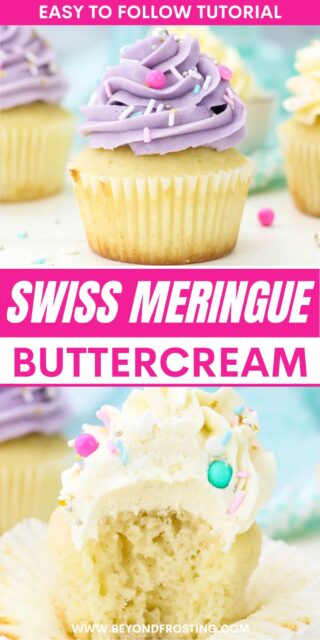
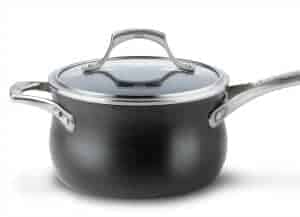

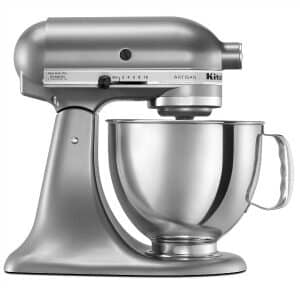
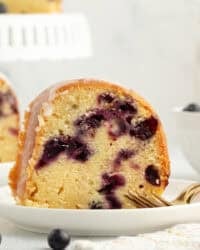
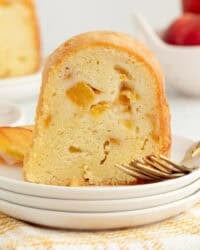
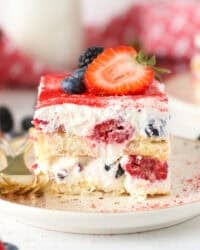

Can I use liquid egg whites instead of cracking eggs?
I have never done that, but I don’t have an exact measurement for you
After making and decorating the cupcakes with the meringue frosting. Do you put in the cupcakes in the fridge or can you leave them on the counter.
Thanks
It depends on your environment. Hot or humid climates would require the frosting to be refrigerated. This buttercream will harden significantly if refrigerated and should be served at room temperature.
This frosting is amazing! It sounds a little intimidating but following the directions as listed it will turn out fabulous! It is honestly my go too frosting now 🙌! I get endless compliments when I make it! Thank you for another great recipe!!
I love to hear that Rebecca, this can definitely be intimidating as it’s so different from American buttercream. I am glad you found this post helpful!
Hi, I’m curious about what if I want to use my buttercream that I’ve put on freezer / refrigerator before, how long does it take to re-whip the buttercream until its ready again? And what kind of mixer attachment do I need to use for re-whipping? Thank youu
Hi Calla, You should only need to rewhip for a couple of minutes, and I would recommend using the paddle attachment.
What kind of mixer speed needed to do the re-whipping process? Thank youu <3
I usually go medium to medium high
Hii, I would love to try making this recipe but when exactly we change the attachment from wire whisk to paddle attachment? After all of the butter goes in or when…? Thank you in advance <3 🙂
Yes, after the butter goes in an it’s mostly incorporated.
how much would a cup of sugar be?
in grams? 190g for 1 cup
How many grams is 2cups of unsalted butter? If you know
1/2 cup is 113grams, so 2 cups would be 454g
Love SMB so much… yes it takes more time, but I find the usual butter cream way too sweet!
You do not need to have the egg Whites at room temp. I mean, you are just going to cook them, right? Also, this goes into the fridge very well. If it loses any fluffiness, you can give it a quick whip before using.
Hi Edie- I think there’s a variety of recipes on the internet that suggest at room temperature and some don’t. It’s just the way I’ve learned and always done it, but to your point, yes you are heating them. Since I am already taking the butter out of the fridge, I take the eggs out as well.
Hi Julianne, this is my favorite icing. I’ve been making it for several years now. I would love to try an Italian Buttercream and a French Buttercream. Do you have recipes for them? If so, hoping you can fit them into your blog. I love getting your recipes.
Hey Linda! I love to hear that! Currently I don’t have an Italian or French Buttercream but it’s something I can do some more research on!
love this recipe and i’ve been using this recipe ever since. 😀
i’m really glad i discovered this. thanks for sharing. i have a question, though. can i use champagne or margarita or tequilla or bailey’s to the buttercream as flavoring instead of vanilla? will it affect the consistency of the buttercream? thanks
HI Rica- I LOVE LOVE LOVE that idea, but I haven’t tried it myself. I’d recommend doing some additional research first.
i did it! i tried it & it turned out great! 🙂